Table of Contents
Books About Cooks (and a Movie)
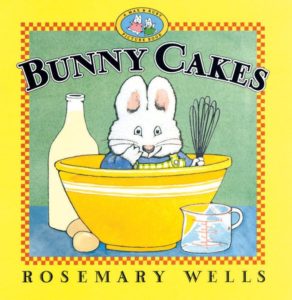
|
In Rosemary Wells’s Bunny Cakes (Viking, 1999), it’s Grandma’s birthday – and Max wants to make her an earthworm cake, while Ruby opts for an angel surprise cake with raspberry-fluff icing. Adorable for ages 3-5. |
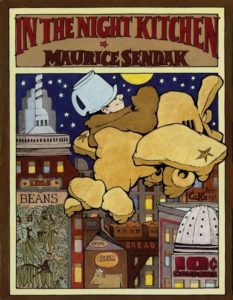
|
In Maurice Sendak’s classic In the Night Kitchen (HarperCollins, 1996), Mickey falls into the surreal world of the night kitchen where three Alice-in-Wonderland-ish bakers are mixing the batter for the morning cake. They need milk – so Mickey makes an airplane out of bread dough and flies off to fetch some from a gigantic milk bottle. In the process of falling into the night kitchen, Mickey also falls out of his clothes, which has caused endless fuss among people who have never seen a child bare. For ages 2-7. |
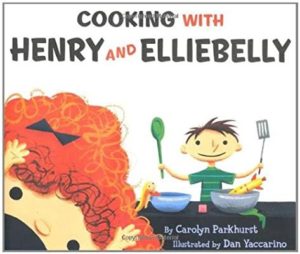
|
In Carolyn Parkhurst’s picture book Cooking with Henry and Elliebelly (Feiwel & Friends, 2010), big brother Henry is hosting a pretend TV show (“Pirate Cooking”), in which the dish of the day is “raspberry-marshmallow-peanut butter waffles with barbecued banana bacon” – though he’s having a struggle dealing with input from red-headed two-year-old sister Ellie. For ages 3-7. |
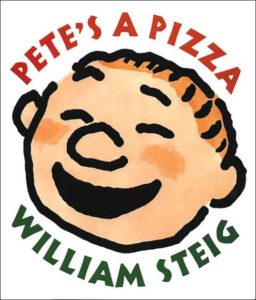
|
In William Steig’s Pete’s a Pizza (HarperCollins, 1998), Pete is miserable – it’s raining and he can’t play ball – so his father decides to cheer him up by turning him into a pizza. Pete is kneaded and tossed, smeared with oil (water), decorated with toppings (checkers and paper scraps), and baked on the couch. When the time comes for the pizza to be sliced, Pete runs away, pursued by his father (“Pizzas are not supposed to laugh!”). Possibly the funniest pizza recipe ever. For ages 4-7. |
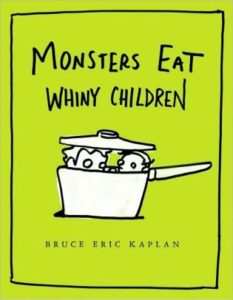
|
Bruce Eric Kaplan’s Monsters Eat Whiny Children (Simon & Schuster Books for Young Readers, 2010) is hilarious. Henry and Eve, going through a “TERRIBLE phase,” do nothing but whine, and have been warned by their father that monsters eat whiny children. The kids continue to whine and – lo and behold – a monster pops them in a sack and takes them off to his lair on the bad side of town. There problems arise, as the monsters bicker over just how to cook and serve whiny children – in salad? Burgers? Cake? Vindaloo? By the time the monsters finally agree on cucumber sandwiches (on fluffy white bread), the whiny kids – hopefully with a lesson learned – have escaped. For ages 4-8. |
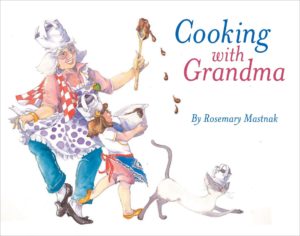
|
Rosemary Mastnak’s Cooking with Grandma (Hardie Grant Egmont, 2012) is a mix of cooking, fun, and make-believe. When Anya visits her grandparents, she and grandma cook a new dish every day, and then serve it up with a dose of pretend play (“room service at the hotel!”). Chances are readers will be clamoring to make toast soldiers and scones. (Mastnak is Australian – readers glimpse kangaroos through Grandma’s kitchen window.) For ages 4-8. |
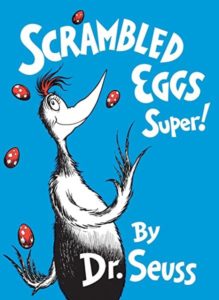
|
In Dr. Seuss’s Scrambled Eggs Super (Random House, 1953, Peter T. Hooper produces the most spectacular dish of scrambled eggs ever, with dozens of zany eggs, 99 pans, 55 cans of beans, a pound of horseradish, and nine prunes. And more. For ages 4-8. |
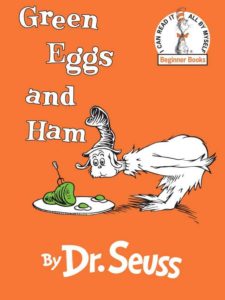
|
Also see Seuss’s Green Eggs and Ham (Random House, 1960) in which the relentless Sam-I-Am pulls out all stops to convince the stubborn narrator to try a scrumptious dish of green eggs and ham. |
| From Martha Stewart, Green Eggs and Ham is a particularly yummy-sounding version of Seuss’s recipe. (The green is pesto.) | |
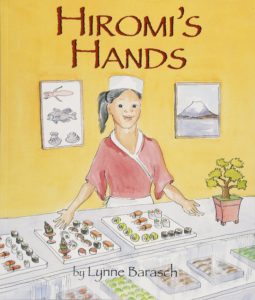
|
In Lynne Barasch’s picture-book biography Hiromi’s Hands (Lee & Low Books, 2007), young Hiromi, whose father is a sushi chef, wants to become one too – and she grows up to become one of the first female sushi chefs in America. (But it wasn’t easy.) For ages 5-8. |
| Make Vegetable Maki Sushi with Kids! has step-by-step photo-illustrated instructions for making homestyle sushi. | |
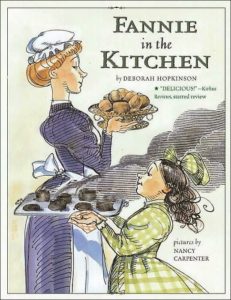
|
Deborah Hopkinson’s picture book Fannie in the Kitchen (Aladdin, 2004) – subtitled “The Whole Story from Soup to Nuts of How Fannie Farmer Invented Recipes with Precise Measurements” – is told from the point of view of young Marcia Shaw, who is not exactly pleased when Fannie Farmer comes to cook for her family’s Victorian household. Soon, though, she’s hooked on Fannie’s delicious meals and even has a hand in writing the famous Boston Cooking-School Cook Book. For ages 5-9. |
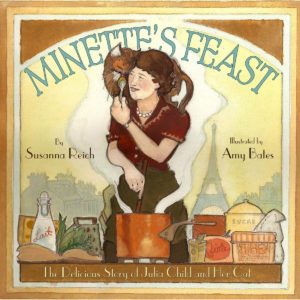
|
By Susanna Reich, Minette’s Feast (Abrams Books for Young Readers, 2012) is the story of Julia Child told through the eyes of her cat, Minette (“perhaps the luckiest cat in all Paris”). For ages 4-8. |
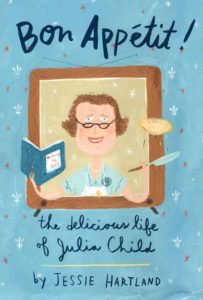
|
Jessie Hartland’s Bon Appetit! (Schwartz & Wade, 2012) is a delightful and hilariously illustrated biography of Julia Child, filled with anecdotes, food, and recipes (and a smattering of French). For ages 7-12. |
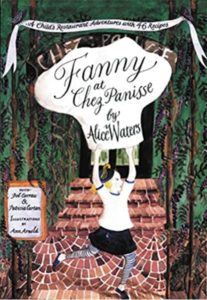
|
By Alice Waters, Fanny at Chez Panisse (William Morrow Cookbooks, 1997) is the charmingly illustrated story of Waters’s famous California restaurant, Chez Panisse, as told by her seven-year-old daughter, Fanny. The first chunk of the book introduces the restaurant and the people who work there; the rest is a collection of 46 scrumptious recipes, ostensibly Fanny’s. For ages 8 and up. |
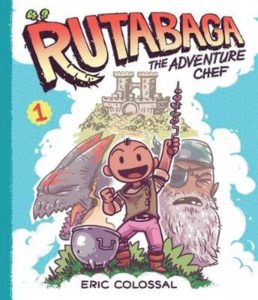
|
In Eric Colossal’s Rutabaga the Adventure Chef (Amulet Books, 2015), Rutabaga copes with danger, dragons, goblins, and more by combining ingredients in his magic cooking pot (named Pot). For ages 7-12. |
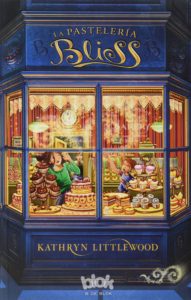
|
In Kathryn Littlewood’s Bliss (Katherine Tegen Books, 2013), the Bliss family, owners of a magical bakery in the town of Calamity Falls, have in their possession an ancient Cookery Booke, filled with arcane recipes for Singing Gingersnaps, Love Muffins, and Cookies of Truth. When the Bliss parents are called out of town, it’s up to 12-year-old Rose and her siblings to keep the book safe – particularly from the suspicious Lily, who arrives at their door claiming to be a distant cousin. For ages 8-12. |
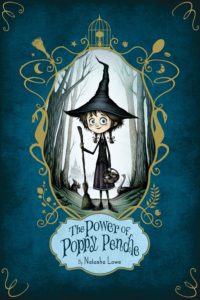
|
In Natasha Lowe’s The Power of Poppy Pendle (Simon and Schuster, 2013), Poppy has inherited the much-coveted witch powers – but she doesn’t want to be a witch. She wants to be a baker. The book includes a dozen recipes. The first of a series for ages 8-12. |
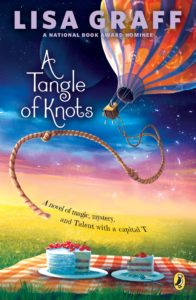
|
Lisa Graff’s A Tangle of Knots (Puffin, 2014) is set in a magical world where everyone has a Talent – and Cady’s is for baking. Mystery, magic, and recipes for cakes. For ages 8-12. |
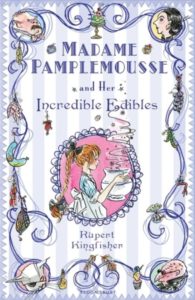
|
In Rufus Kingfisher’s Madame Pamplemousse and Her Incredible Edibles, Madame Pamplemousse’s edibles are indeed incredible: among them are Minotaur Salami, Pterodactyl Bacon, Crocodile Kidneys in Blueberry Wine, and Giant Squid Tentacle in Jasmine-Scented Jelly. Young Madeleine – forced to work for her awful Uncle Lard at his restaurant, The Squealing Pig – discovers Madame Pamplemousse when the Squealing Pig runs out of pate, at which point evil Uncle Lard decides to steal Madame Pamplemousse’s secrets. A wonderful magical read for ages 9 and up. (And there are sequels.) |
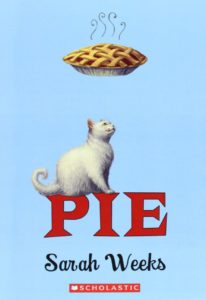
|
In Sarah Weeks’s Pie (Scholastic, 2013), set in the 1950s, Alice’s Aunt Polly – the Pie Queen of Ipswitch – has died, leaving the recipe for her famous pie crust to her cat, and her cat (Lardo) to Alice. Great characters, a mystery, a story of friendship and family relationships, and fourteen recipes for pie. For ages 9-12. |
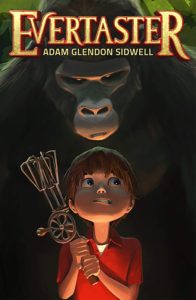
|
In Adam Glendon Sidwell’s Evertaster (Future House Publishing, 2012), eleven-year-old Guster Johnsonville, a mega-picky eater, is taken by his frustrated mother to New Orleans to find something he’ll consent to eat. There they meet a dying pastry cook who gives them an old metal eggbeater and the secret ancient recipe for the most delicious taste in the world. Soon Guster and family are on the run, pursued by a cult of murderous chefs. Several sequels. For ages 9-12. |
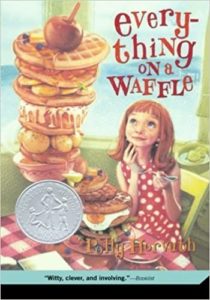
|
The parents of Primrose Squarp, the star of Polly Horvath’s Everything on a Waffle (Square Fish, 2008), have been lost at sea, and Primrose has been sent to live with her Uncle Jack (who at least is better than her former babysitter, Miss Perfidy, who smells of mothballs and dislikes children). Primrose spends her time on the docks, waiting for her parents to return, and hanging out with Miss Bowzer, proprietor of the restaurant The Girl on the Red Swing, where everything – absolutely everything – is served on a waffle. Miss Bowzer teaches her to cook – the book is filled with recipes for everything from caramel apples to pear soup and cherry pork chops – and Primrose’s observations on the people and life in her small Canadian town are priceless. Also there’s a happy (though somewhat unbelievable) ending. For ages 9 and up. |
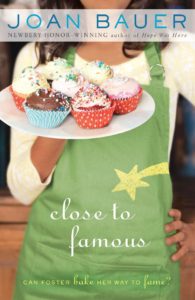
|
Twelve-year-old Foster McFee, main character of Joan Bauer’s Close to Famous (Puffin, 2012), has learning disabilities (she can’t read), a talent for baking (marvelous cupcakes), and a dream of hosting her own television cooking show. When she and her mother settle in Culpepper, West Virginia – after fleeing her mother’s abusive boyfriend – both find new friends and new hope. A satisfying read for ages 10 and up. |
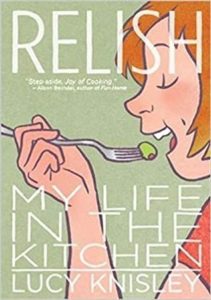
|
Lucy Knisley’s Relish: My Life in the Kitchen (First Second, 2013) is a cheerful autobiographical graphic novel of a child “raised by foodies,” with lots of great illustrated recipes. For food-loving teenagers and adults. |
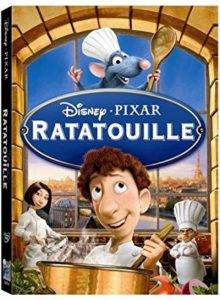 |
In Pixar’s 2007 animated film Ratatouille, Remy, a young rat, dreams of becoming a great French chef. The major drawback: he’s a rat. Rated G. |
